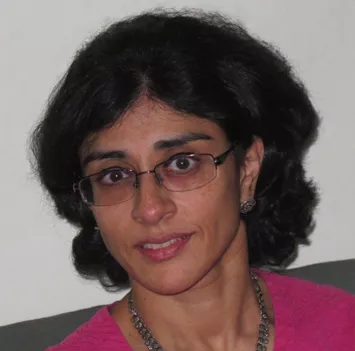Of Destiny, Domains and Dance
Historical Studies prof studies religion, urban history and memory in South Asia from colonial times to present day

When Professor Malavika Kasturi set out on her research career investigating masculinity in elite households in agrarian India, she didn’t know she would consistently be stepping out of the folds of her selected subject matter, but she understands that is the way research paths often unfold.
“I started out as a gender historian, but then began branching off into religion, the cultural histories of religion, and monasticism, which was out of my comfort zone,” says Kasturi, a faculty member in U of T Mississauga’s Department of Historical Studies, whose first book in 2002 was Embattled Identities: Rajput Lineages and the Colonial State in Nineteenth-Century North India.
Since then, Kasturi has been writing, researching and publishing on monasticism. She has been working on a monograph on monastic orders, and the making of Hindu nationalism in 20th-century India, a project that was funded by a SSHRC Standard Research Grant in 2008. A large part of this work centres on Banaras, or Kashi, a city in northern India that is regarded and primarily studied as the ‘holiest of Hindu pilgrimage cities,’ Kasturi is completing a stint of research leave in India, where she was on two back-to-back research fellowships, and has just wrapped up this project with a book manuscript ready to go.
Kasturi plans to continue to write and research on histories of religion, and monasticism. But now she is looking to add complexity to the way pilgrimage centres are regarded by studying Banaras in a new light, given that it has a significant Muslim population, and is a heterogenous urban space. This character of Banaras is largely lost in stereotypical representations of the city.
Kasturi’s newest project, which also received funding from SSHRC (see related Insight story), examines the long-running role that elite Muslim families and households played in shaping urban history and urban space in Banaras from the eighteenth century to the present, particularly focusing on the imperial families of the imperial Mughal dynasty.
Using a range of methodologies to conduct her research, Kasturi begins with textual archives, newspapers and colonial records in India, as well as in England. She will be working in four different languages – Hindi and English, as well as Urdu and Farsi when examining the private family records of the Mughals. She also will be looking at local municipal and police records in Banaras, and conduct interviews with a whole range of people, including the family of the Mughals, who found their way to the city in the eighteenth century, and who have since made it their home. Through a close reading of elite Mughal households and their relationship with the city, Kasturi will try and understand the relationship between memory and the multiple constructed pasts of urban spaces like Banaras.
Additionally, having become increasingly interested in architecture and built space, Kasturi is also looking at visual markers such as graveyards, shrines, mosques, and secular buildings erected by this elite Muslim family, and their subsequent influence on urban space in Banaras. Kasturi is working with architects and visual culture scholars to look at the spaces and sights important for her research in Banaras, consulting old maps and comparing them to current environs.
“So, now the learning curve will be very sharp,” says Kasturi. “I am trying to understand the intersection between memory and urban space, by looking at material culture, buildings, objects, and photographs, Ethnographic fieldwork, and not just textual materials will be the most important part of my research.”
Outside the realm of her research, Kasturi recently slipped back into her comfort zone, returning to one of her great passions: dance, particularly Kathak, which is a north Indian classical dance form.
“I started dancing when I was seven, and continued with it until I began serious research and fieldwork as a graduate student,” says Kasturi. “I am now taking it up again with my seven-year-old daughter in India, because one of my biggest regrets is that I gave it up at all.”
Kasturi has every intention of continuing with Kathak when she comes back to Toronto, because it’s a very vigorous dance form and provides a perfect outlet for movement after spending so much time in archives, sitting, reading and writing.
“I dance for about seven hours a week, and it’s great because you use and train your entire body,” says Kasturi.
“It’s the antithesis of research, which is very sedentary – stuck at a computer or in a library – and now I am just trying to convince my daughter that it’s a good idea,” she says with a laugh.
By Carla DeMarco
